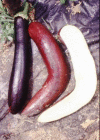Genetically modified parthenocarpic eggplants: improved fruit productivity under both greenhouse and open field cultivation
- PMID: 11934354
- PMCID: PMC101493
- DOI: 10.1186/1472-6750-2-4
Genetically modified parthenocarpic eggplants: improved fruit productivity under both greenhouse and open field cultivation
Abstract
Background: Parthenocarpy, or fruit development in the absence of fertilization, has been genetically engineered in eggplant and in other horticultural species by using the DefH9-iaaM gene. The iaaM gene codes for tryptophan monoxygenase and confers auxin synthesis, while the DefH9 controlling regions drive expression of the gene specifically in the ovules and placenta. A previous greenhouse trial for winter production of genetically engineered (GM) parthenocarpic eggplants demonstrated a significant increase (an average of 33% increase) in fruit production concomitant with a reduction in cultivation costs.
Results: GM parthenocarpic eggplants have been evaluated in three field trials. Two greenhouse spring trials have shown that these plants outyielded the corresponding untransformed genotypes, while a summer trial has shown that improved fruit productivity in GM eggplants can also be achieved in open field cultivation. Since the fruits were always seedless, the quality of GM eggplant fruits was improved as well. RT-PCR analysis demonstrated that the DefH9-iaaM gene is expressed during late stages of fruit development.
Conclusions: The DefH9-iaaM parthenocarpic gene is a biotechnological tool that enhances the agronomic value of all eggplant genotypes tested. The main advantages of DefH9-iaaM eggplants are: i) improved fruit productivity (at least 30-35%) under both greenhouse and open field cultivation; ii) production of good quality (marketable) fruits during different types of cultivation; iii) seedless fruit with improved quality. Such advantages have been achieved without the use of either male or female sterility genes.
Figures




References
-
- Nothman J, Koller D. Effects of growth regulators on fruit and seed development in eggplant (S. melongena L.). J Hort Sci. 1975;50:23–27.
-
- Romano D, Leonardi C. The responses of tomato and eggplant to different minimum air temperature. Acta Hort. 1994;366:57–66.
-
- De Ponti OMB. Breeding parthenocarpic pickling cucumbers (Cucumis sativus L.): necessity, genetical possibilities, environmental influences and selection criteria. Euphytica. 1976;25:29–40. doi: 10.1007/BF00041526. - DOI
-
- Philouze J. Parthenocarpie naturelle chez tomate. II. Etude d'une collection varietale. Agronomie. 1985;5:47–54.
-
- Restaino F, Onofaro-Sanajà V, Mennella G. Facultivative parthenocarpic genotypes of eggplant obtained through induced mutations. XIII Eucarpia Congress, 6–11 July, Angers, France. 1992. pp. 297–298.
Publication types
MeSH terms
Substances
LinkOut - more resources
Full Text Sources
Other Literature Sources

